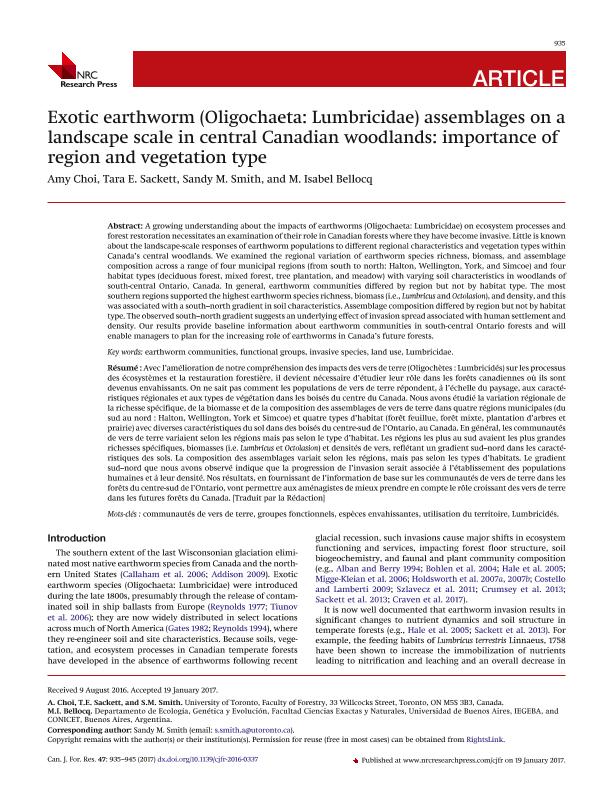Mostrar el registro sencillo del ítem
dc.contributor.author
Choi, Amy
dc.contributor.author
Sackett, Tara E.
dc.contributor.author
Smith, Sandy M.
dc.contributor.author
Bellocq, Maria Isabel

dc.date.available
2018-11-27T19:06:18Z
dc.date.issued
2017-08
dc.identifier.citation
Choi, Amy; Sackett, Tara E.; Smith, Sandy M.; Bellocq, Maria Isabel; Exotic earthworm (Oligochaeta: Lumbricidae) assemblages on a landscape scale in central Canadian woodlands: Importance of region and vegetation type; National Research Council Canada-NRC Research Press; Canadian Journal Of Forest Research; 47; 7; 8-2017; 935-945
dc.identifier.issn
0045-5067
dc.identifier.uri
http://hdl.handle.net/11336/65368
dc.description.abstract
A growing understanding about the impacts of earthworms (Oligochaeta: Lumbricidae) on ecosystem processes and forest restoration necessitates an examination of their role in Canadian forests where they have become invasive. Little is known about the landscape-scale responses of earthworm populations to different regional characteristics and vegetation types within Canada’s central woodlands. We examined the regional variation of earthworm species richness, biomass, and assemblage composition across a range of four municipal regions (from south to north: Halton, Wellington, York, and Simcoe) and four habitat types (deciduous forest, mixed forest, tree plantation, and meadow) with varying soil characteristics in woodlands of south-central Ontario, Canada. In general, earthworm communities differed by region but not by habitat type. The most southern regions supported the highest earthworm species richness, biomass (i.e., Lumbricus and Octolasion), and density, and this was associated with a south-north gradient in soil characteristics. Assemblage composition differed by region but not by habitat type. The observed south-north gradient suggests an underlying effect of invasion spread associated with human settlement and density. Our results provide baseline information about earthworm communities in south-central Ontario forests and will enable managers to plan for the increasing role of earthworms in Canada’s future forests.
dc.format
application/pdf
dc.language.iso
eng
dc.publisher
National Research Council Canada-NRC Research Press

dc.rights
info:eu-repo/semantics/openAccess
dc.rights.uri
https://creativecommons.org/licenses/by-nc-sa/2.5/ar/
dc.subject
Earthworm Communities
dc.subject
Functional Groups
dc.subject
Invasive Species
dc.subject
Land Use
dc.subject
Lumbricidae
dc.subject.classification
Otras Ciencias Biológicas

dc.subject.classification
Ciencias Biológicas

dc.subject.classification
CIENCIAS NATURALES Y EXACTAS

dc.title
Exotic earthworm (Oligochaeta: Lumbricidae) assemblages on a landscape scale in central Canadian woodlands: Importance of region and vegetation type
dc.type
info:eu-repo/semantics/article
dc.type
info:ar-repo/semantics/artículo
dc.type
info:eu-repo/semantics/publishedVersion
dc.date.updated
2018-10-23T18:40:00Z
dc.journal.volume
47
dc.journal.number
7
dc.journal.pagination
935-945
dc.journal.pais
Canadá

dc.journal.ciudad
Otawa
dc.description.fil
Fil: Choi, Amy. University of Toronto; Canadá
dc.description.fil
Fil: Sackett, Tara E.. University of Toronto; Canadá
dc.description.fil
Fil: Smith, Sandy M.. University of Toronto; Canadá
dc.description.fil
Fil: Bellocq, Maria Isabel. Consejo Nacional de Investigaciones Científicas y Técnicas. Oficina de Coordinación Administrativa Ciudad Universitaria. Instituto de Ecología, Genética y Evolución de Buenos Aires. Universidad de Buenos Aires. Facultad de Ciencias Exactas y Naturales. Instituto de Ecología, Genética y Evolución de Buenos Aires; Argentina. Universidad de Buenos Aires. Facultad de Ciencias Exactas y Naturales. Departamento de Ecología, Genética y Evolución; Argentina
dc.journal.title
Canadian Journal Of Forest Research

dc.relation.alternativeid
info:eu-repo/semantics/altIdentifier/doi/https://dx.doi.org/10.1139/cjfr-2016-0337
dc.relation.alternativeid
info:eu-repo/semantics/altIdentifier/url/http://www.nrcresearchpress.com/doi/10.1139/cjfr-2016-0337#.W_2VFjgzbmg
Archivos asociados
